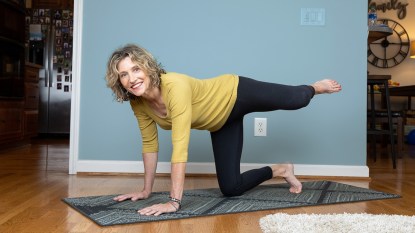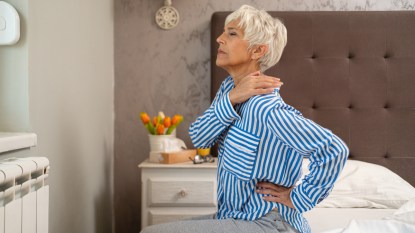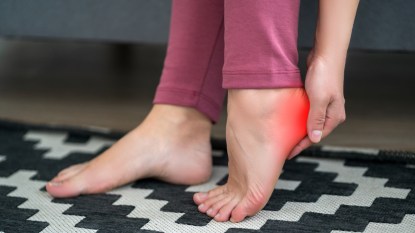Sore, Creaky Knees? These Stretches for Knee Pain Ease Discomfort and Improve Mobility
See the 6 expert-backed moves that help make every step pain-free
Knee pain comes in many forms. It can strike above or below the knee, on the kneecap itself, behind the knee or on the inner or outer side of the knee. The joint may feel swollen or stiff, or it may hurt to put weight on it. Often, the discomfort is caused by medical conditions such as arthritis. But it can also stem from an injury (like a sprain or strain) or overuse (like tendonitis or bursitis). No matter the cause, you may assume you’re resigned to some quality time on the couch with an ice pack. But in happy news, a few simple stretches for knee pain can go a long way toward easing the ache and preventing future flare-ups.
The benefits of stretches for knee pain
Range of motion naturally decreases as we get older, especially after age 55. Without consistent stretching, your muscles shorten. This can put extra stress on all of your joints, including your knees.
“With many types of knee pain, it is likely that there are also associated muscle length restrictions,” says Alexa Rohach, DPT, a physical therapist at the Performance Therapy Center at Providence Saint John’s Health Center in Santa Monica, CA. “Commonly tight muscles include hip flexors, hamstrings and quadriceps. If one of these muscle groups is shortened, it can place excess strain on the opposing muscle group. As a result, we may alter the way we walk, run or lift to compensate.” (Click through to see the vitamin that stops age-related muscle loss.)
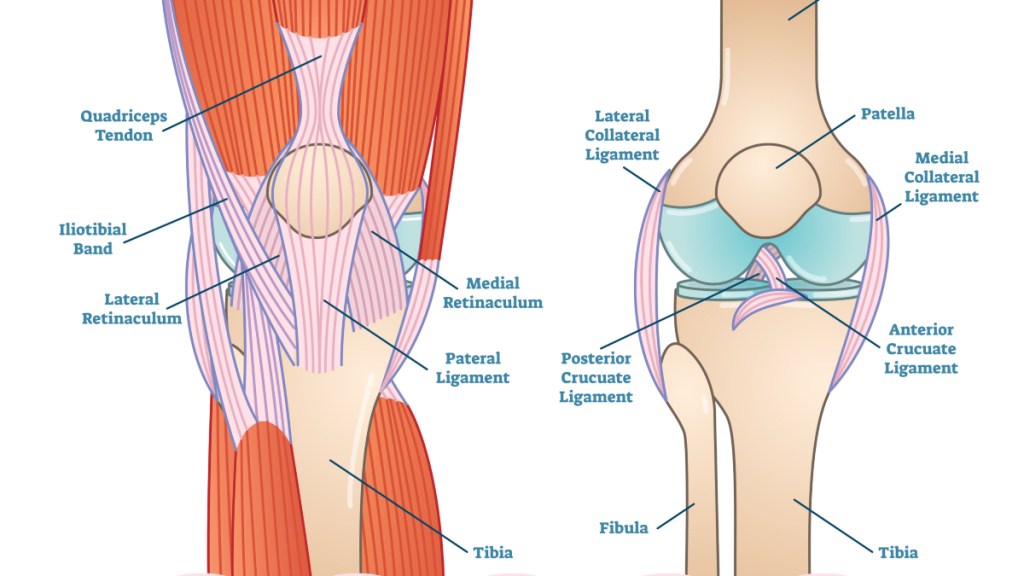
Over time, that contributes to discomfort. “Stretching can help knee pain because it helps improve the elasticity of the muscles that surround the knee,” says Denise Smith, PT, CMPT, a physical therapist and owner of Smith Physical Therapy + Running Academy in Crystal Lake, IL. “When those tissues have more movement, they stop pulling on the bones or joint, which can alleviate knee pain.”
Of course, if you think your knee pain may be caused by an injury or medical condition, talk to a doctor or physical therapist before starting a stretching routine.
Related: Doctors Reveal the 5 Best Self-Care Tips That Ease Arthritis Pain — No Pricey Rx Required
The best stretches for knee pain
Maintaining flexibility keeps your muscles pliable and prepared for movement. Plus it can lessen your risk of injury. That’s why we asked trainers, physical therapists and sports medicine specialists to share their favorite stretches for knee pain.
Pro tip: Rohach recommends performing each static stretch three to five times, holding for 30 to 60 seconds each time. Why? This helps to reduce guarding, a natural response in which the muscles tighten up in response to pain. “Sustained holds are particularly helpful,” she adds. “It allows the muscles to relax and minimize guarding, especially when approaching a joint’s end range. Ultimately, it provides a better quality stretch with longer lasting effects.” (Try cuing up some favorite tunes, too. Neural nostalgia eases pain.)
Ready to get started? Check out these six easy stretches for knee pain.
Related: What Causes Inside Knee Pain + How Can You Fix It? Experts Share Home Remedies That Actually Work
1. Side-lying quad stretch
“The quadriceps muscle stretch is a good stretch to help alleviate knee joint or knee cap pain,” says Karena Wu, PT, DPT, Board-Certified Clinical Specialist in Orthopedic Physical Therapy and Clinical Director of ActiveCare Physical Therapy in NYC. This stretch is often done while standing, but it can be tricky if your quads are tight or you struggle with balance. Instead, try the easier — but just as effective — modified version. It’s done while lying on your side, so you can focus on the stretch instead of worrying about toppling over.
To do:
- Lie on your right side with your right knee slightly bent for a little extra stability.
- Bend your left knee and reach for your left ankle or foot with your left hand.
- Gently pull your left foot towards your rear end. You should feel a stretch in the front of the thigh.
- Repeat on the opposite side.
2. Seated hamstring stretch
“Tight hamstrings can contribute to knee pain by increasing stress on the knee joint,” says Andrew White, NASM-CPT, a personal trainer and the co-founder of Garage Gym Pro. “This stretch helps by loosening the hamstrings, reducing the pull on the back of the knee and alleviating tension. It’s particularly beneficial for pain at the back of the knee.”
To do:
- Sit on the floor with your right leg extended in front of you and your left leg bent. Rest the bottom of your left foot against the inside of your right inner thigh.
- Lean forward from your hips and reach towards your right foot. Grab your toes, ankle or knee, depending on your flexibility. Keep your back straight and avoid rounding your shoulders.
- Hold, then switch sides.
Tip: If mobility prevents you from sitting on the floor, Rohach recommends modifying this exercise with a chair. Sit in a chair with your feet flat on the floor, then extend one leg out and rest your heel on the floor. “Leading with the chest, slowly lean forward until you feel a stretch in the back of your thigh,” she says. Repeat on the opposite side.
3. Hip flexor stretch
When your hips are tight, it can prevent your leg from traveling behind your body properly as you walk. This can put stress on your knees as they help to compensate for the decreased range of motion. Rohach recommends this simple bed stretch to open up your hips.
To do:
- Start by lying on the edge of your bed with your left leg hanging off. Keep your right leg bent and your lower back pressed into the mattress. You should feel a stretch in the front of the left hip.
- Hold, then repeat on the other side.
4. Supine butterfly stretch
You probably remember the standard butterfly stretch from gym class in school, or from practicing yoga. “This stretch helps with pain on the inside of the knee,” Smith says. “It works on improving the elasticity of the inner thigh muscles that attach to the inside, or medial, aspect of the knee.” (Click through to learn how yoga eases menopause symptoms, too.)
This modified version is performed while lying on the floor, which can be easier for those with tight hips. Lying on your back “helps to fix your pelvis, allowing for a deeper stretch and mobilization to the inside of the hip,” Smith adds.
To do:
- Start by lying on your back. Bend both knees and place your feet flat on the floor, as close to your butt as you comfortably can.
- Place the bottoms of your feet together as you let your knees fall out to the side.
- Hold, then repeat.
5. Wall calf stretch
“This stretch helps relieve pain on the back on the knee,” says Josh Schlottman, CSCS, a certified strength and conditioning specialist in Napa, CA. “The calf muscle attaches to the back of the knee, so stretching can help reduce tightness in the area. This movement also stretches the hip flexors on the front of the hips, which will help relieve knee pain, too.”
To do:
- Stand about a foot away from a wall, facing the wall with your feet hip-width apart.
- Place your hands on the wall at shoulder height, with your hands shoulder-width apart.
- Keeping your hands on the wall, take a small step back with your left foot.
- Keep your left heel on the ground as you gently move your knees forward towards the wall. You should feel a gentle stretch in your calf muscles.
- Repeat on the other side.
6. 90/90 stretch
The iliotibial (IT) band is a thick band of tissue that runs down the outside of your leg, from your hips to your knee. An overuse injury called IT Band Syndrome is a common cause of knee pain, especially among people who do repetitive exercises.
The IT band itself can’t be stretched, Smith says, but you can alleviate IT band pain by stretching the surrounding muscles. And this stretch is “an absolute must for pain on the outside of the knee,” Smith says. “The 90/90 stretch helps loosen up the hip to improve the mobility of that ball and socket joint. This allows the IT band to not pull so much on the bones where it adheres.”
To do:
- Sit upright on the floor with your knees bent and your feet flat on the floor.
- Drop your right knee to the right, so your right knee is bent at a 90-degree angle and the outside of your right leg is flat on the floor.
- Drop your left knee to the right, drawing your left foot back behind your body. The inside of your left leg should be flat on the floor, with your left knee bent at a 90-degree angle.
- If this position is challenging, hold the stretch here. If you need an additional stretch, gently lean forward over your right knee, leading with your chest, until you feel a stretch.
- Switch legs and repeat on the opposite side.
For more ways to outsmart joint pain from head to toe:
Doctors Reveal the 5 Best Self-Care Tips That Ease Arthritis Pain — No Pricey Rx Required
Research: Castor Oil Packs Proven to Relieve Joint Pain, Constipation & Menstrual Cramps
Joint Pain + Rash May Be Early Warning Signs of Psoriatic Arthritis — Here’s What Can Help
This content is not a substitute for professional medical advice or diagnosis. Always consult your physician before pursuing any treatment plan.





